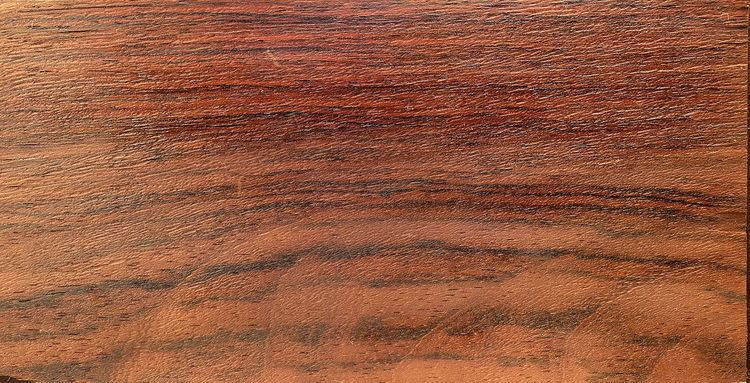 | ||
Rosewood refers to any of a number of richly hued timbers, often brownish with darker veining but found in many different hues.
Contents
True rosewoods
All genuine rosewoods belong to the genus Dalbergia. The preeminent rosewood appreciated in the Western world is the wood of Dalbergia nigra which is now a CITES-listed endangered species on Appendix 1, which means no commercial sales for wood that is cut after 1992. It is best known as Brazilian Rosewood, but also as Bahia rosewood. This wood has a strong sweet smell, which persists for many years, explaining the name rosewood.
Another classic rosewood comes from Dalbergia latifolia known as (East) Indian rosewood or sonokeling (Indonesia). It is native to India and is also grown in plantations elsewhere in Pakistan(chiniot).
Madagascar rosewood (Dalbergia maritima), known as bois de rose, is highly prized for its red color. It is overexploited in the wild, despite a 2010 moratorium on trade and illegal logging, which continue on a large scale.
Throughout southeast Asia Dalbergia oliveri is harvested for use in woodworking. It has a very fragrant and dense grain near the core, however the outer sapwood is soft and porous. Dalbergia cultrata that has variegated burgundy to light brown color, a blackwood timber is sold as Burmese Rosewood. Products built with rosewood based engineered woods are sold as Malaysian Rosewood or as Dalbergia oliveri.
Some rosewood comes from Dalbergia retusa, also known as the Nicaraguan rosewood or as palisander is controlled by CITES under Appendix 2 which allows some commercial activity. Several species are known as Guatemalan rosewood or Panama rosewood: D. tucerencis, D. tucarensis, and D. cubiquitzensis. Honduran rosewood:D. stevensonii, also on CITES Appendix 2, is used for marimba keys, guitar parts, clarinets and other musical and ornamental applications.
Not all species in the large genus Dalbergia yield rosewoods; only about a dozen species do. The woods of some other species in the genus Dalbergia are notable—even famous—woods in their own right: African blackwood, cocobolo, kingwood, and tulipwood. The woods of some other species are usable for tool handles at best.
Other
The timber trade will sell many timbers under the name rosewood (usually with an adjective) due to some (outward) similarities. A fair number of these timbers come from other legume genera; one such species that is often mentioned is Bolivian Machaerium scleroxylon sold as Bolivian rosewood. Another that may be found in market from Southeast Asia is Pterocarpus indicus, sold as New Guinea rosewood (and related species). Dalbergia sissoo is timber from rosewood species from India and Bangladesh, usually known as Sheesham or North-Indian Rosewood. It is extremely dense and has mild rot resistance, but it is porous and its exterior is soft and susceptible to wood-boring insects. It is used for making cabinets, flooring and carving. It is exported as quality veneers. Due to its after work quality when sealed and dyed, it is often sold as genuine rosewood or as teak. It has no discernible qualities of a genuine rosewood. It has comparable strength with teak, but lower quality and price than teak or Dalbergia latifolia.
Although its wood bears no resemblance whatsoever to the true rosewoods, the Australian rose mahogany (Dysoxylum fraserianum, family Meliaceae) and Australian Blackwood, (Acacia melanoxylon) is also sold as rosewood. Australian rose mahogany due to the strong smell of roses from freshly cut bark is more mistakenly called as a "rosewood".
Uses
All rosewoods are strong and heavy, taking an excellent polish, being suitable for guitars (the fretboards on electric and acoustic guitars often being made of rosewood), marimbas, recorders, turnery (billiard cues, fountain pens, black pieces in chess sets, etc.), handles, furniture, and luxury flooring, etc. Rosewood oil, used in perfume, is extracted from the wood of Aniba rosaeodora, which is not related to the rosewoods used for lumber.
In general, world stocks are poor through overexploitation. Some species become canopy trees (up to 30 m high), and large pieces can occasionally be found in the trade. Rosewood is now protected worldwide. At the recent summit of the international wildlife trade in South Africa, CITES (the Convention on International Trade in Endangered Species of Wild Fauna and Flora) moved to protect the world’s most trafficked wild product by placing all 300 species of the rosewood tree under trade restrictions.
The dust created from sanding rosewood is considered a sensitizing irritant and can trigger asthma and other respiratory ailments. Often, the more a person is exposed to rosewood dust, the more sensitive they can become to exposure.
Genuine rosewood product characteristics
Machine carved pieces are more lean in waste but more prone to damage than hand carved pieces, especially for Rosewood. Qualitative craftsmanship is seen by the locks and joints of the product. Qualitative service by industrial standards in pricing is based upon the total material cost. The woodwork charge and the profit margin is calculated as 25% (2010) to 40% (2016) of the material cost. Certain non-professional groups charge by per square feet of the work to be done and at times per hour rather than the work done, which was viewed as unethical through case studies. Though per square feet calculations are used in industrial manufacturing settings to estimate the work done by multiple person's but only in the above stated margins. If the product is sold through the stores, then the pricing comes not more than the double of cost of material used in a rounded figure, considering the selling expenses (store expenses, delivery, care, etc.).
